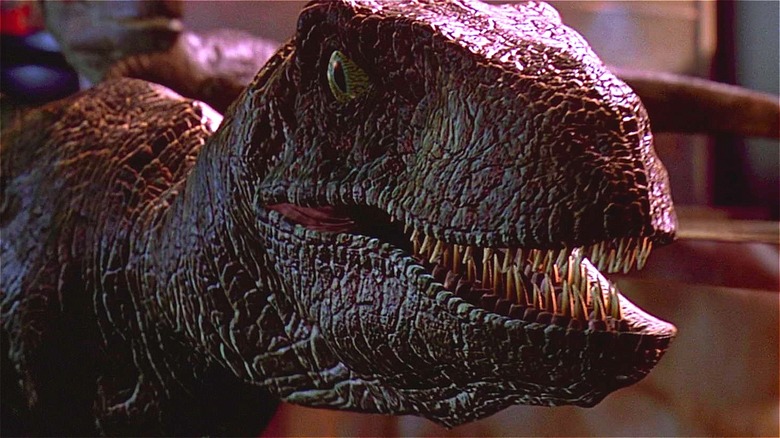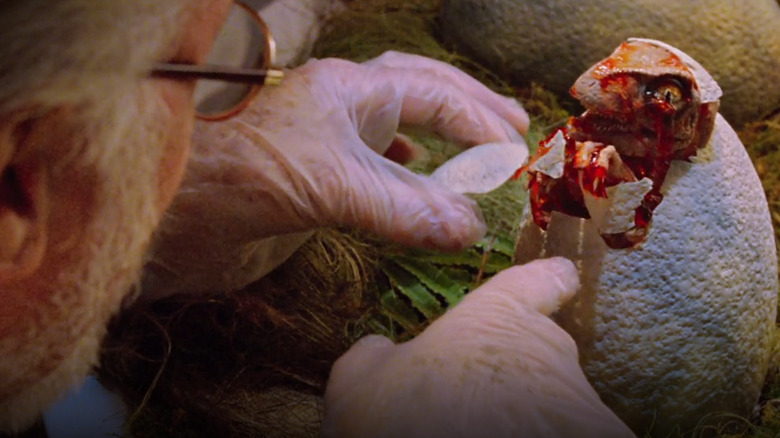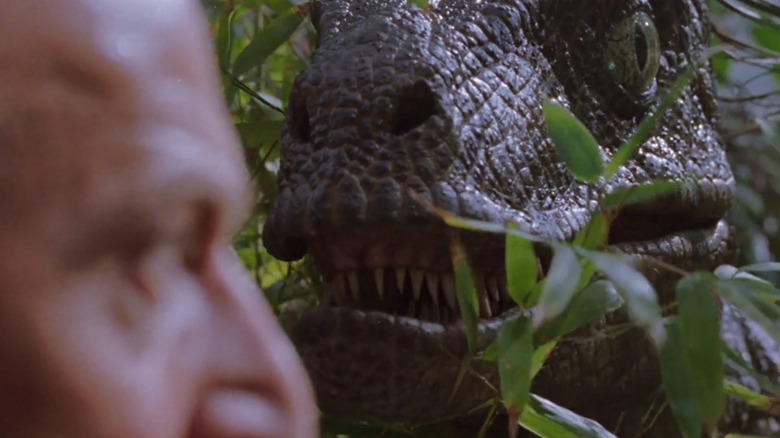Jurassic Park's Velociraptors Are Completely Wrong According To Science
You might think that if someone was going to create a theme park filled with dinosaurs, they might want to populate it with herbivores. Then again, people do enjoy their meat-eating and death-dealing creatures. Aside from the flagship Tyrannosaurus Rex in the "Jurassic Park" franchise, the most notable dinosaur is the Velociraptor, which represents a far more relatable threat than the "terrible lizard king" on account of their intelligence, size, and pack behavior. Where the T-Rex may be considered a battering ram, the Velociraptor is more like a surgeon's scalpel -– that is, if a surgeon's scalpel had retractable toe claws meant for disemboweling.
As game warden Robert Muldoon (Bob Peck) establishes in the first film, Velociraptors are lethal, cunning, and follow a pack mentality. Able to figure out how doors work, the Velociraptors stalk survivors with their characteristic honks and snarls, even setting up ambush attacks, as observed in the iconic "clever girl" scene in "Jurassic Park." Velociraptors may be one of the best-known dinosaurs in the "Jurassic Park" franchise, but it turns out most of what the film tells us about Velociraptors is incorrect — right down to the name.
The author of Jurassic Park used an incorrect source
Although the first "Jurassic Park" film was released in 1993, the book which inspired it was written by Michael Crichton in 1990, according to the author's website. It is also noted that Crichton started writing the early stages of the story in 1983 and worked on it for several years before its completion.
In a Variety interview with paleontologist Jim Kirkland, the scientist explained some basic inaccuracies regarding Velociraptors in the film. Kirkland said, "There had been a book that lumped Deinonychus into Velociraptor, which is stupid." The book that caused these problems is Gregory S. Paul's "Predatory Dinosaurs of the World." According to Kirkland, Michael Crichton used this 1988 book while researching the novel.
Considering these comments, it seems as if Crichton based the information in his book on incorrect facts, which then extended into the film series. This means that the name Velociraptor is used while depicting an entirely different species.
The raptors in Jurassic Park were actually based on the Deinonychus species
According to Brittanica, Velociraptors were significantly smaller in real life and weighed no more than 100 pounds. This means that the fearsome bipedal predators featured in the "Jurassic Park" franchise can't really be called Velociraptors, although there are similar species that would fit the bill, like Utahraptors and Deinonychus. Per Brittanica, the Deinonychus species was actually used as the inspiration for the "raptors" in Jurassic Park, and they typically measured around eight feet long and weighed around 100 to 150 pounds.
As reported by Fossil Guy, both Deinonychus and Velociraptors belong to a genus of dinosaurs called dromaeosaur. Beyond that, recent studies have established that the species that constitute the genus were fully feathered, even though the idea of dinosaurs being feathered was still relatively new in the early 1990s. This means that what the general public lovingly refers to as "raptors" in Jurassic Park is a bit of a misnomer, and the correct nomenclature is actually Deinonychus — though that would have been much harder to yell in terror!


